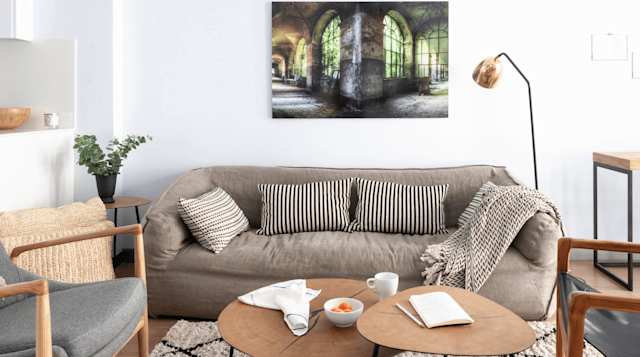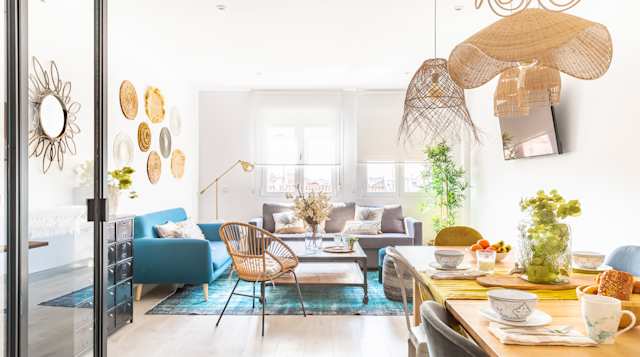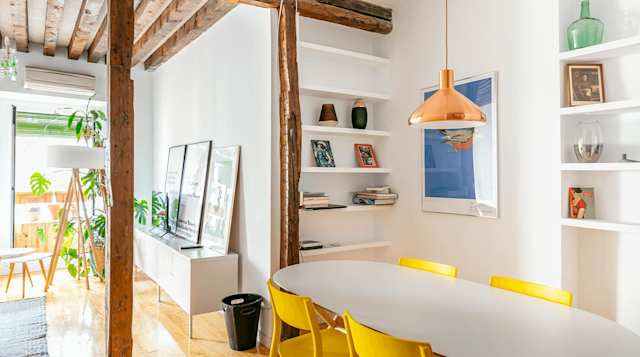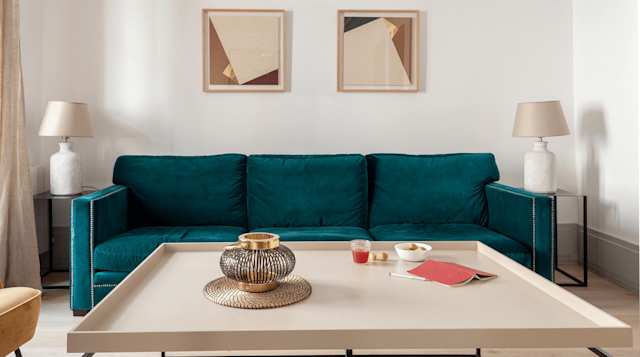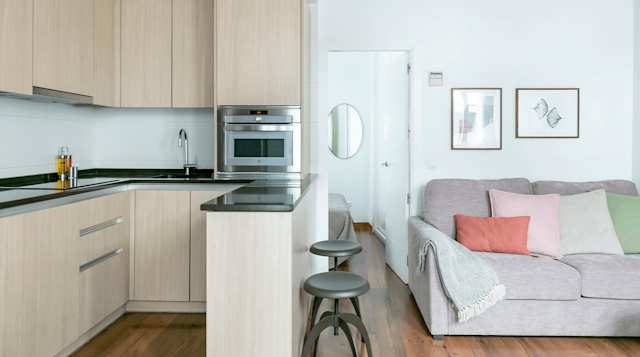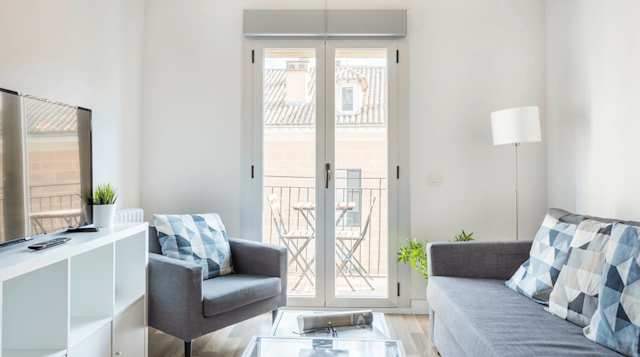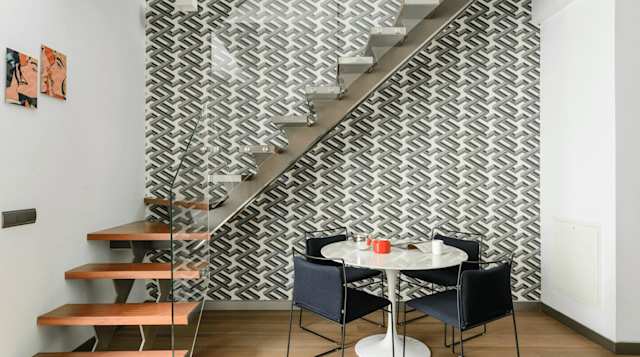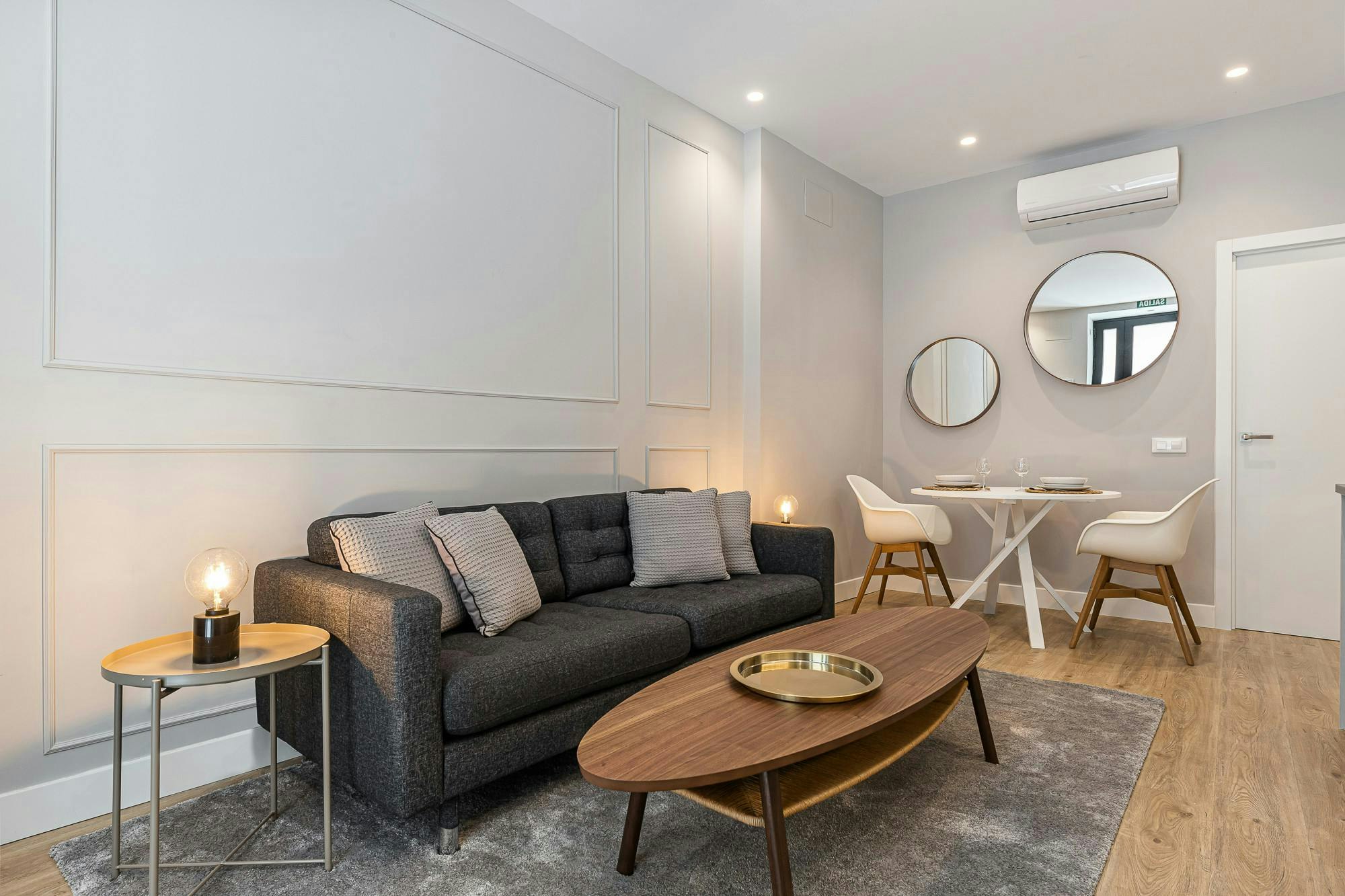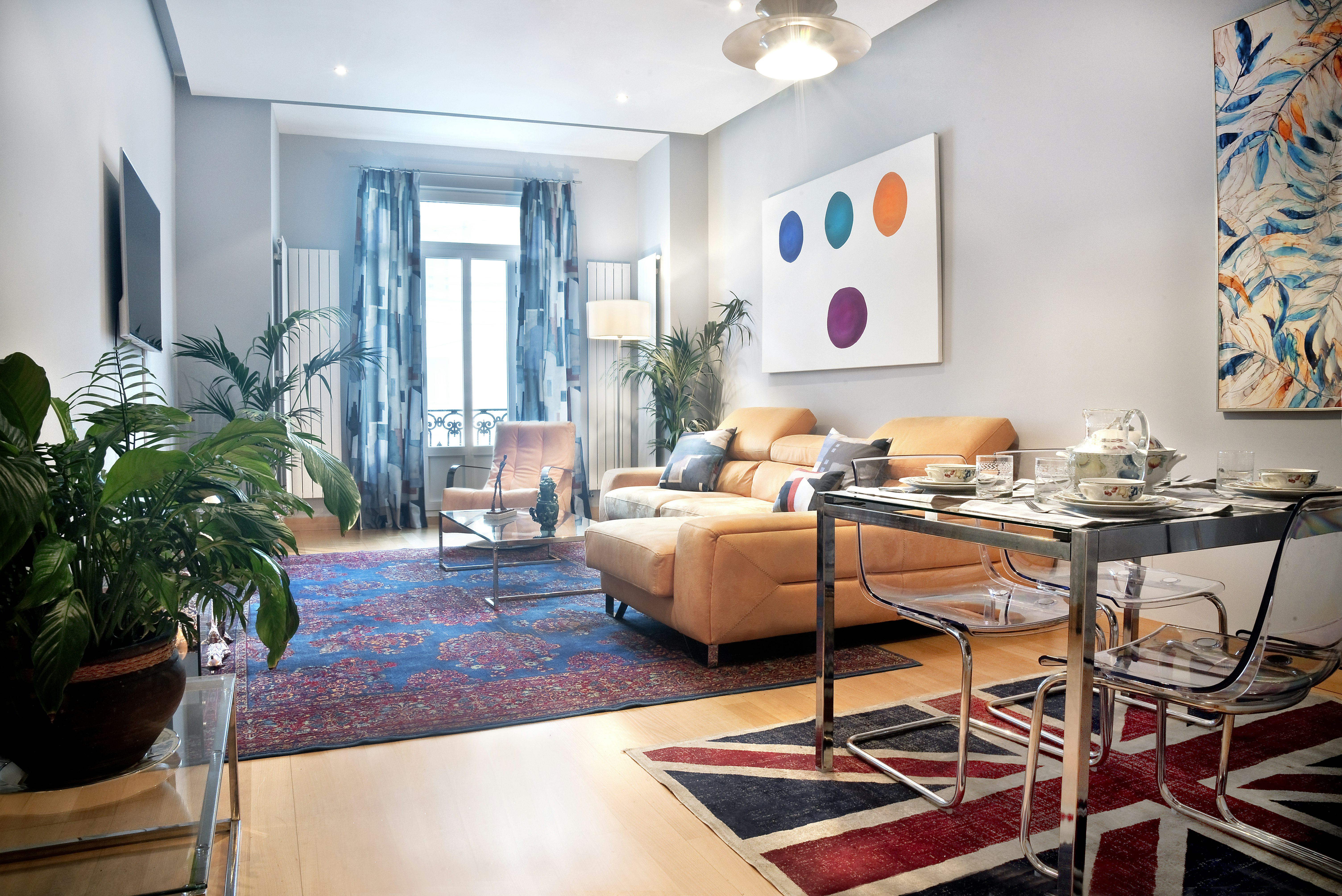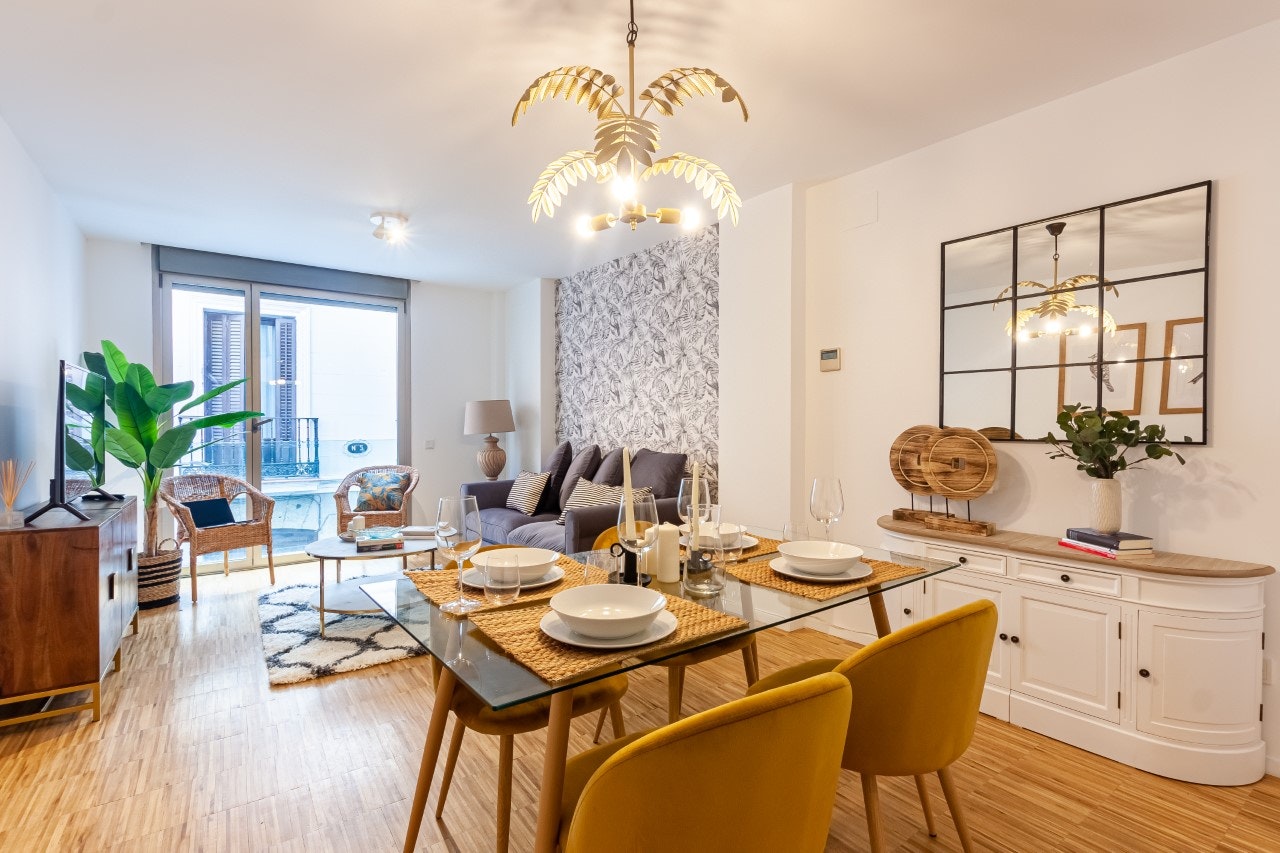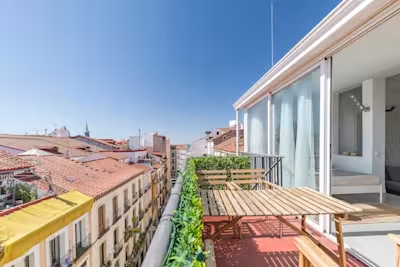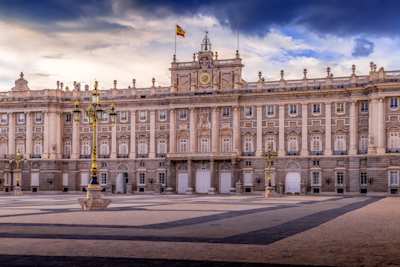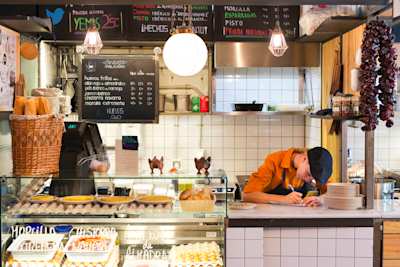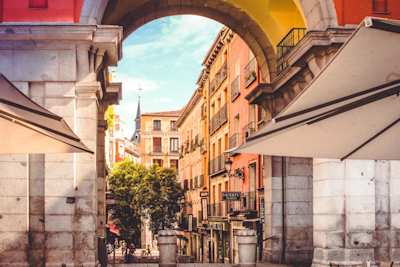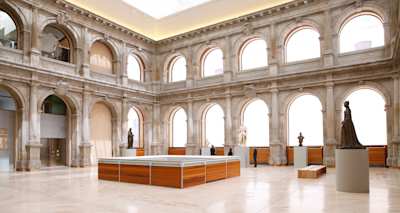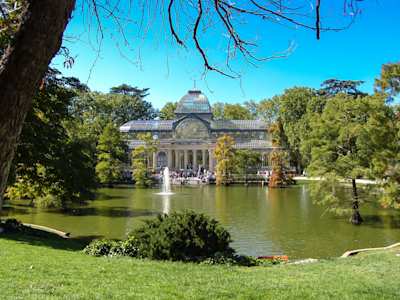Where to Stay in Madrid: All You Need to Know
Here we reveal our favourite places to stay in the Spanish capital, from Salamanca to Chamberí.
~
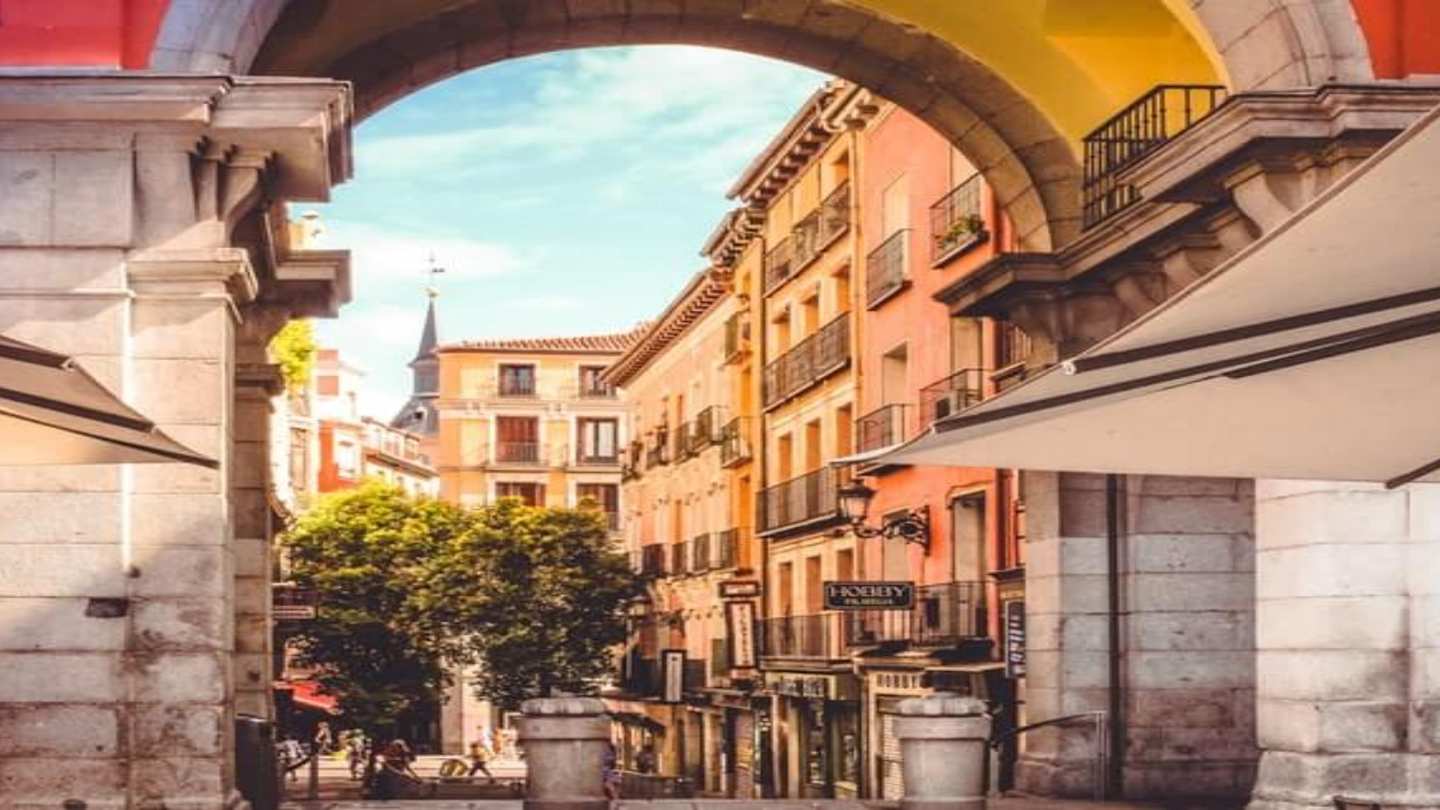
From Goya to Guernica, football to flamenco, skyscrapers to street art - Madrid is an always moving metropolis that contains layers of multitudes. It’s a beguiling mix of old and new, an epicenter for both business and creativity, and boasts world-class museums that are on any art lover’s bucket list. Above and beyond all that though, it’s a really great place to sit back, relax and enjoy a drink or two. Park yourself down on a terrace, crack open a caña (beer) and while away the better part of an afternoon and evening in the sun, people watching and snacking on olives, tostas, and jamon. Bliss.
As always, we here at Plum Guide want to make sure you do Spain’s capital right, so read on for more hot tips and tricks for what to do and where to stay in Madrid.
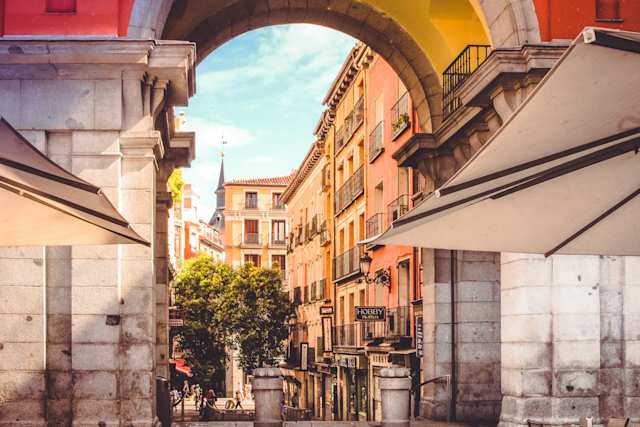
Archway in Plaza Mayor, Madrid
This neighborhood gets its name from 17-year-old Manuela Malasaña, a bold young woman who defended her home to the death against Napoleon's troops back in the day. Her spirit of rebellion carried on in the post-Franco counterculture movement of the 80s, which infused the area with a surge of artistic tour-de-force. Pedro Almodovar is just one of many residents who made it big. This trendy area is still young and alive, although it's decidedly more hipster than punk these days. Between colorful street art on every corner (much of which has been painted by local up-and-coming artists), a cool restaurant scene, and independent boutiques, this is the beating heart of the city for all the cool youth.
Your day in Malasaña begins as all days should - with some good coffee. Today it’ll come by way of HanSo Café. Once you're sufficiently perked up, weave your way in and out of Malasaña’s streets, each one adorned with bright murals. For a spot of culture, head to Centro Cultural Conde Duque. This former barracks is now a hip art space encompassing a library, revolving exhibitions, and the Museum of Contemporary Art.
Once you're done with the morning's culture, it should be somewhere around early afternoon. As such, Madrid custom dictates it’s time for a vermouth. La Ardosa is the spot for this - their red vermouth and Spanish omelettes have been a mainstay of the neighborhood since 1892.
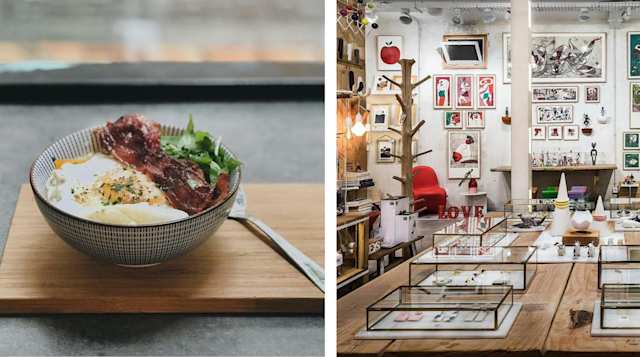
A bowl of food and store interiors
From there, meander along (feeling that mild buzz of mid-afternoon drinking), popping in and out of shops along the way. Direct yourself to Hijo de Epigmento for Spanish ceramics and textiles from Mallorca, El Moderno for quirky art and home accessories and Antiqua Casa Crespo, the oldest shoe store in the city, for their famed canvas espadrilles. Some of the city’s best vintage shops can be found here too, most of them congregated along Calle de Velarde. Vintalogy alone should keep you busy for an hour or two - it’s said to be the biggest thrift store in Europe. La Mona Checa is another local favorite, while Heritage & Rare is the go-to for expertly curated pieces sourced by industry experts.
For dinner, you'll be pleased to hear you have no shortage of choice. Mercado de San Ildefonso is a cool street food market in an industrial setting. Right across the street, Tienda
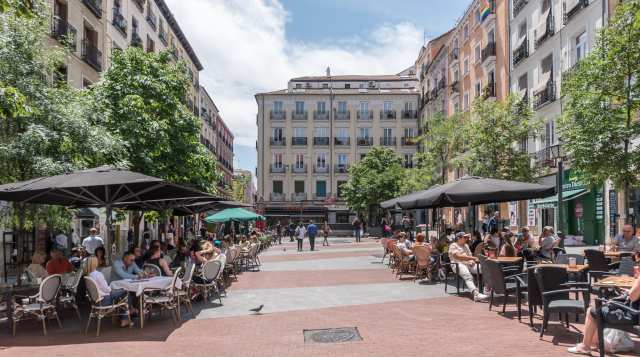
A square of terrace restaurants and bars in Madrid
This is Madrid’s gay village and home to a thriving community of trend-setters and hipsters. Like its friend and neighbor Malasaña, Chueca’s charm comes from its independent shops and lively nightlife. Leave your wonderful Plum home in the area and start the day with influencer-approved coffee and truly great lighting at Hermanas Arce, before poking around the area’s many boutiques. We love Ecoalf for designs made from recycled materials, with sustainability at heart, while Patromono Olivarero is an absolute mecca for olive oils (so make sure to bring some home as a souvenir). For a little art and culture around here, the Museo del Romanticismo is an 18th-century manor that offers a taste of what life was like for a noble-person of that era - complete with having one’s own private collection of Romantic (as in, the time period, not the theme) art.
In the afternoon, peruse Mercado San Anton, an international market offering everything from bagels to truffles to sushi, before having a picnic at El Retiro. Or, climb to the market’s fourth floor for a rooftop drink. For dinner, Gastromaquia is a local gem for creative fare, while Casa9 offers a daily-changing menu of market-fresh plates that won’t break the bank. But it’s well after dinner time that Chueca really comes alive. Studio 54 replicates the vibes of the New York original with interiors by Tomas Alia, while Macera does beautifully crafted cocktails using small-batch liquors and homemade ingredients.
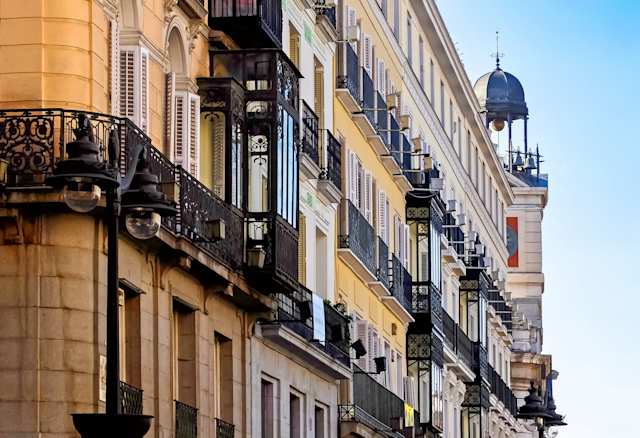
Building facade in Madrid
Not as swanky as Salamanca but not as young and grungy as Malasaña, Chamberí has a charm of its own and is where to stay in Madrid if you want to live like the locals. Between a flourishing cultural scene, plenty of places for a great meal, and a thriving business hub, this mostly residential neighborhood is less touristy than some of the others but still boasts plenty to do and see.
It may not be the Golden Triangle of Art, but if you’re after a dose of more local culture, Chamberí has plenty to offer amongst its residential streets and high-end boutiques. Starting with a leisurely brunch is a must around here - Perrachica is beautiful and does a great spread towards the Trafalgar district, while Mallorca Market is the one for dining al fresco thanks to their pretty terrace. The latter is also a bustling, upscale food market, so while you’re here, have a poke around. One of the neighborhood’s most unique offerings is Estacion Museo Chamberí, a former metro station dating back to 1919 that’s completely frozen in time. On one hand, it has a strange dystopian feeling, while also making you feel like you’re on the set of a 1950’s film, which is an intersection we feel strangely comfortable with.
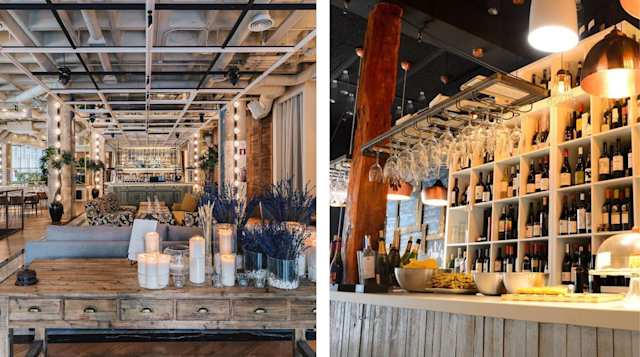
Interiors at bars and restaurants in Chamberí
For something a little more current, try Galería Machado-Muñoz, which has contemporary art exhibits along with some interesting interior design. Museo Sorolla houses works by Spanish artist Joaquin Sorolla - he may not be Picasso or Goya, but we think his stuff deserves a spot on your itinerary all the same. Chamberí’s boutiques are as good an excuse as any to visit this area, especially if you have a few extra euros to burn. La Alpargateria makes beautiful espadrilles, while NAC boutique has seasonal collections of distinctly Spanish fashions with some pieces from international designers. Their window displays will lure you in even if their clothes don’t.
Come evening, Lakasa is a shockingly un-touristy spot for seasonal, game-centric fare by big deal chef Cesar Martin. If you go, order the beef Wellington. Another meat-heavy must-try is Sala de Despiece. Designed to look like an industrial butcher’s, it has amazing interiors and incredible food, but is often busy (you’ll have to queue). For drinks, head to Taberna Averias for 400 different wines and a staunch no-beer policy. Finish your evening with a classic film at Cine Verde, a cinema that’s been around since 1958 and still shows the same programs, or local theater at Teatro de la Abadia, a community theater dedicated to promoting social change with their productions. Like the sound of this neighborhood? Make it your home away from home during your trip to Madrid by staying in one of our homes like Toquilla.
Once home to Spain’s literary golden boys - Lope de Vega, Quevedo, Góngora, and Cervantes - Barrio de las Letras somehow retains its bohemian, old-world feel despite being a stone’s throw from the famed Golden Triangle of Art. Amongst odes to the literati, this neighborhood is also dotted with contemporary art galleries and exciting gastronomy. The best thing to do here (as we would argue, it is anywhere) is simply to wander. Weave in and out of narrow streets and larger boulevards, taking note of occasional tiles underfoot, scrawled with quotes from Spain’s literary masters. Be sure to stop by La Integral, a gallery-market concept selling works by local artists and designers behind the facade of an old confectionery, and Casa Museo Lope de Vega, the home of 16th-century Spanish writer, which also houses a private art collection. In stark contrast to the literary legacy around here, the visual arts scene in this barrio is all modern - check out Formatocomodo for works by young artists, Ponce + Robles for contemporary Spanish art, and The Goma for conceptual installations.

A dish of razor clams and the interiors of a restaurant

orange Carrasco signage
Lavapiés is a lively, multicultural neighbourhood with medieval streets that climb through the neighbourhood like ladders, giving way to its main arteries painted with colourful murals by local street artists. Relatively low prices mean that newcomers to the city still flock here, as well as young people, artists and a whole host of other creative types. The neighbourhood is known for its annual festival, Fiesta de San Lorenzo, which takes place every August 10th. For this day (and the rest of the week, really) the streets turn into one big party, with music, drinks aplenty, and general merriment. The rest of the time, the lively spirit here is still palpable.
Mercado San Fernando, a traditional Latin American market where you can now find relics from all four corners of the world, is emblematic of the neighbourhood’s character and a great place to start. Eat your way through stalls selling empanadas, pasteis de nata, tacos, ramen, and Spanish charcuteries, leaf through books at Casqueria, and sip natural wines at Bendito Vinos y Vinilos. We could happily spend all day here, but we have a strong and unwavering love for markets that we don’t expect all of you to share, so at some point, you’ll likely want to move on.
When that time comes, Casa Blanca, as traditional of a Moroccan tea house as you’ll find in Spain, offers a moment of repose. Afterwards, have a gander at La Tabaclera, a cooperative cultural space where locals can set up exhibits, screenings, talks, gigs etc. Housed in an old tobacco factory, the building has a cool, eclectic feel.
For dinner, dig into Senegalese food at Dakar, or for something quicker and cheaper, grab a samosa at one of the many stalls around the neighbourhood. In fact, you could happily compose a meal of all the street food around here. There are some really great bars in Lavapiés too: El Eucalipto is a small yet always fun Cuban bar with great mojitos, fresh juices, and often dancing (later on, anyway); La Fisna Vinos is a small wine bar for local, small-batch Spanish wines; and El Juglar is a laidback spot for drinks and live music (often jazz or soul), with Flamenco on Sundays. Stay in one of our beautiful homes here like Abejorro to be at the heart of the action.
Home to arguably the busiest and best tapas scene in Madrid (and maybe even the world), La Latina’s narrow cobbled streets give way to Piazza-like squares where tourists and locals alike flock for cocktails, caña, and tapas. Two neighbourhood markets and a treasure trove of churches give the area a lively and charming character. Wander the maze-like streets and you’ll stumble upon beautiful churches and basilicas, the most notable of which is the neo-classical Basilica de San Francisco el Grande, which houses a Goya fresco. Capilla del Obispo is a striking chapel worth checking out too and has been standing here since the 16th century.
If it’s a Sunday, you’ll spend the morning perusing the stalls of El Rastro, a popular flea market selling clothing and antiques, which spills out onto the side streets. Local antique shop merchants often join in on the fun, setting up stalls on Sundays in accordance with the flea. Take advantage, because it’s a rarity for anything to be open on a Sunday in Spain.
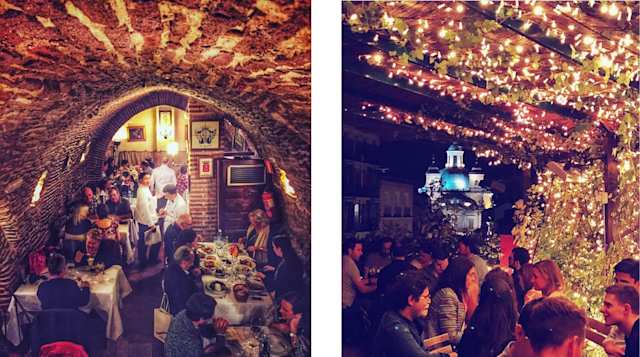
Interiors of a restaurant and an outdoor bar full of people socialising
If it’s any other day of the week, your market fix will come by way of Mercado de la Cebada. Over a hundred years old, this neighbourhood icon blends tradition with some important updates. Here, you’ll find local merchants selling fresh juices, fish, jamon, and produce, alongside a handful of more artisanal offerings. Afterwards, wander down Calle Ruda, stopping at La Tienda de la Cerveza for a craft beer before popping in and out of the street’s characterful shops.
And now, for the real reason you came to this neighbourhood: tapas. The highest concentration of tapas bars is along Cava Alta and Cava Baja, though all the neighbourhood's squares will have many a place to eat and drink. Hemingway was once a regular at local haunts like La Venencia, a sherry (and sherry only) bar seemingly untouched by time, and the oldest restaurant in the world, El Sobrino de Botin. It’s 300 years old, always packed, and makes a damn good suckling pig. Next, direct your attention to the artsier vibes of Maria Pandora, a kitschy and slightly uncanny-feeling champagne bar where the tapas of choice are plates of fruit and sweets. They also host regular poetry readings.
Want something classic but not pretentious? Alcamen de Vinos, with its tiled floor, tostas, and tapas is as authentic as it gets, while El Viajero boasts a leafy rooftop terrace for good food and pretty views. If the crowds of the piazzas get to be too much, Principe de Anglona Garden is a beautifully landscaped spot hidden behind the Anglona Palace, where you can have a quiet moment. We also love Sala Equis, an old XXX movie theatre which now is just a regular movie theatre and cultural venue, showing currents and classics in a crumbling, partially-covered courtyard. Once you're ready to call it a night, head back to your wonderful Plum home and rest up ready for your next day of exploring.
Not really a whole neighbourhood, but this small section between Centro and Barrio de las Letras is probably one of the most well-trodden in the city. Madrid’s museum trifecta, Museo del Prado, Reina Sofia Museum, and Museo Nacional Thyssen Bornemisza are all here and accounted for, with their world class art waiting to be seen. If you do it right, you could spend a whole week in this Golden Triangle of Art. Start your day with coffee and a bite at Nubel, conveniently located inside the Reina Sofia and generally deemed better than Prado’s cafe. You’ll then, of course, spend the morning at the museum, ogling 20th-century art - most notably, an impressive Picasso collection, along with Dali, and Serra (amongst many, many others).
Try to make it out in time for lunch, at which point you can get some fresh air and wander around the Botanical Gardens before sitting down for a nice meal on the terrace at Spanish Farm, which fittingly serves Spanish, farm-fresh dishes. Make sure to finish your meal with a cafe con leche, because you’ll need energy for the rest of the afternoon. Up next is the museum monolith, Museo del Prado. One of the undisputed greatest art museums in the world, here you’ll find works by Goya, Caravaggio, Raphael, Bosch, Rubens, Titian, and Valasquez. Lose yourself here all afternoon, or just do the highlight reel and try to squeeze in your third stop: the Thyssen. One of the largest private collections in the world, the Thyssen has everything from the Italian Renaissance through to German Expressionism.

Grand archway in Madrid and The Spanish Farm restaurant
In the evening, you could easily stay in the area for dinner, though the central location of this micro-neighbourhood means you’re also not far from plentiful options around Gran Via or the less touristy offerings of Barrio de las Letras. Should you choose to stay close to home though, Viridiana is helmed by celebrity chef Abraham Rivera and serves inventive fusion dishes. Just up the street, Horcher retains old world glamour (think waiters in tuxedos and white tablecloths) and a game-heavy menu.
Puerta del Sol & Gran Via
If Madrid is a galaxy, then Puerto del Sol is its aptly-named sun. Bang in the centre of everything, the city’s major roads fan out from here, including Gran Via, Madrid’s most famed street. You’ll find some of the city’s most important monuments here, from the New Years’ clock tower to the statue of a bear and a strawberry tree, representing the city’s slightly perplexing coat of arms. Grand Belle-Epoque edifices sit next to modern skyscrapers, visual reminders of Madrid’s effortless blending of old and new.
Head out from your lovely Plum home like Tete's Collection and start at Kilometre 0 at Puerta del Sol, the point from which all distances in Madrid are measured. From there, take in the palatial-looking, all white Madrid Post Office, where the famous clock which chimes in the New Year is located. Though it looks impossibly grand, it’s still a functioning post office - pick up a postcard from one of the many stalls around here and send it off inside, just to say you did.
From here, you’ll also be able to see La Osa y el Madroño (the bear and the strawberry tree), that statue representing the city’s coat of arms that we mentioned earlier. Meander onto Mercado de San Miguel to snack on tapas, or engage in a little retail therapy along Gran Via, lined with international designers and high-street shops. If you’re in town to catch a football game, Santiago Barnabeu Stadium is a quick 15-minute metro ride from here.
Being well-catered to tourists, there is no shortage of places to eat, drink, and party around Centro. However, with a handful of notable exceptions, the offerings around here are not the best of the best. Our solid bets: Chuka Ramen Bar is the best of its kind in the city and a nice change from all that Spanish food, and Casa Labra is a veritable institution for tapas, dating back 100 years. Wherever you end up, save room for dessert at Chocolateria San Ginés, which doles out piping hot churros and thick, muddy hot chocolate 24/7.
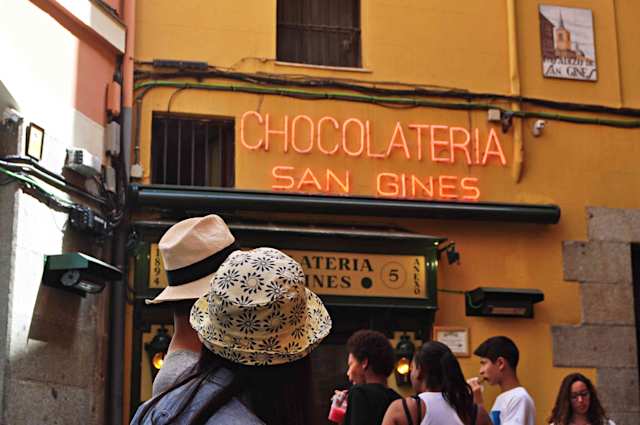
People standing outside Chocolateria San Ginés
Los Austrias
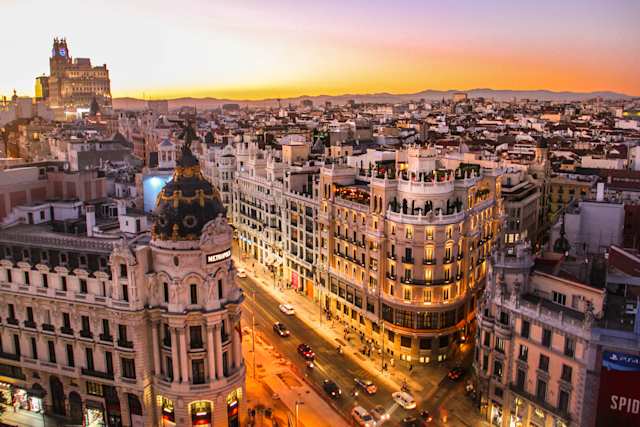
Aerial view of central Madrid at sunset
Madrid’s most storied history can be found in this quarter, once the stomping grounds of the Habsburg Dynasty. With its neoclassical gardens, Royal Palace and regal churches, this barrio was the former city centre and remains an important relic of the country’s golden age in the 16th century. A day in Madrid’s most regal quarter is best spent walking from one monument to the next, taking in the imperial splendour and rich history. Plaza Mayor is the centre of it all, once Madrid’s city centre and now home to several tourist-centric businesses. Once you’ve taken it in, you’ll head to Monasteria de Corpus Christi las Carbonaras, where cloistered nuns prepare traditional sweets and cookies and dole them out from a small wooden window. From there, the next stop is Almudena Cathedral - it took 110 years to finish, and as a result is a real mishmash of styles, which is interesting to see. You’ll be in the royal gardens now, so make your way to the neighbourhood’s most popular landmark, the Royal Palace. While it’s still the official residence of the Queen, she’s hardly ever in town except for state ceremonies.
Spend the afternoon wandering the Jardin de Sabatini, beautiful neoclassical gardens adjacent to the Palace. Monasterio de las Descalzas, a 16th Century convent that’s still running, is another popular stop along this tourist route. However, you can only visit with an official tour guide, many of whom don’t speak English, and there’s little to no information available about any of the relics inside. We say save yourself the trouble and just admire it from the outside. When it comes to dinner, La Bola serves cocido Madrileño from classic clay pots. Otherwise, head to Taberna El Lio, a wine bar with an extensive list, also offering tapas by Michelin-starred chef Pepe Rodriguez for very reasonable prices. Treat yourself to a nightcap before heading back to your delightful Plum home away from home.
The ritziest of Madrid’s barrios, Salamanca boasts upscale boutiques, Michelin stars, and incredibly well-dressed folk aplenty. Your top-tier couturiers all have outposts here, along with the most prestigious bullfighting ring, a handful of museums, and beautiful homes along its 19th-century boulevards. If you’re the type of tourist who ambles around with a dust-covered bag, unfortunate trainers, and a sweat-streaked face (no judgement, this is us most of the time too) you probably will feel slightly amiss in Salamanca. This upscale neighbourhood is beautiful, and so are the people who come to hang out here. Think you'd fit right in? Then Salamanca is your answer to where to stay in Madrid, so be sure to choose a charming Plum apartment in the area to call home throughout your trip. Calle José Ortega y Gasset is Spain’s answer to the Champs Elysées, meaning that this is where you’ll find Spain’s flagship stores for Cartier, Louis Vuitton, Chanel, and Abercrombie & Fitch (when is somebody going to tell them to stay in their own lane?). The real must-do on this street though is Oriol Balaguer, a patisserie from the chef behind the 'Best Dessert in the World' title from years past and former-colleague of Ferran Adria. Come here for some of the best pastries and chocolate confections you’ll likely ever have.
Hit a few more shops before lunch, at which time you should direct yourself to Platea, an old cinema which is now a gourmet food hall full of trendy restaurants and cocktail bars. Continuing on, Plaza de Toros Monumental de Las Ventas is worthy of a few hours. The most prestigious bullfighting ring in the world, it still holds fights in the summer. Museo Taurino, located within the complex, is a museum all about this most controversial and classic Madrileno sport. If bullfighting isn’t your thing, Museo Lazaro Galdiano, an early 20th-century mansion with an impressive private art collection, is a nice alternative. In the evening, splash out at one of Salamanca’s Michlin-rated fine dining establishments: Ramon Freixa, two Michelin-star holder at the Hotel Unico Madrid; Albora, which earned a star for its elegant take on Spanish dishes; or StreetXO, the more casual, Asian-inspired outpost from the purveyors of three Michelin-starred DiverXO. If that’s not in the budget or if you’ve not managed to get reservations, Banibanoo serves very good traditional Iranian food in a pretty yet more chilled setting.
Want to keep reading? Take a look at our guide to Barcelona, or perhaps our itinerary for a long weekend in Barcelona next. After that, we're sure you'll be tempted to a trip to the city so be sure to browse our collection of homes, expertly curated by our home critics to ensure only the highest of standards.
